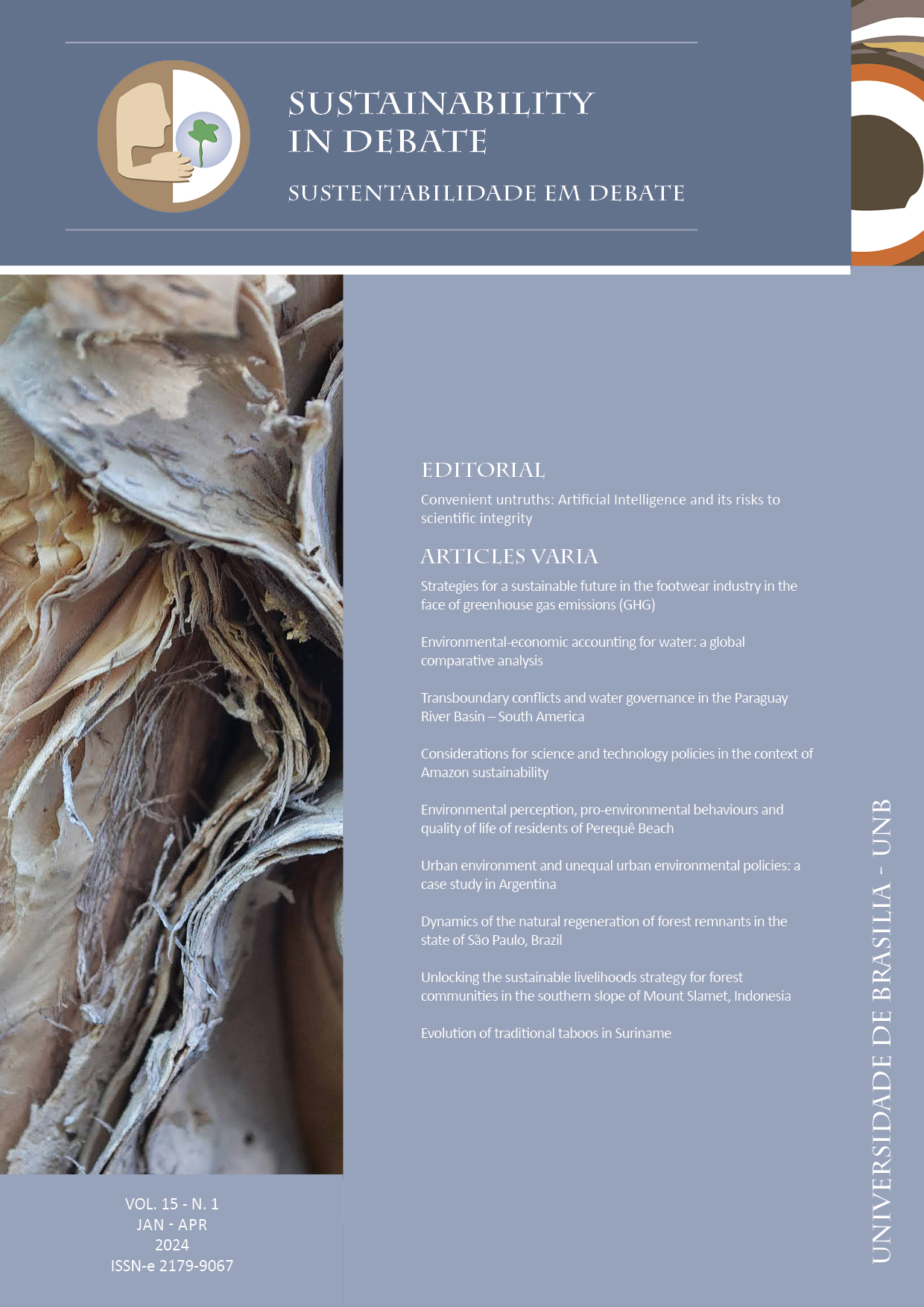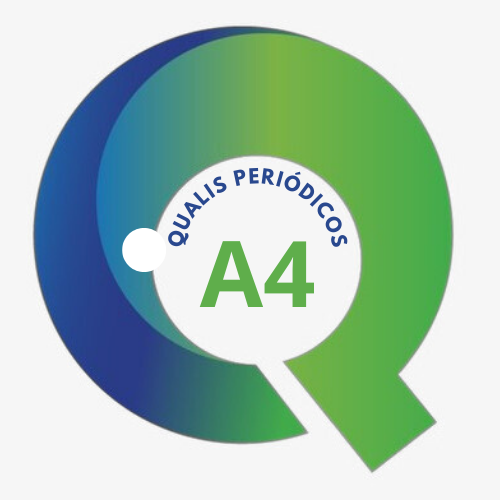Evolução dos tabus tradicionais no Suriname
DOI:
https://doi.org/10.18472/SustDeb.v15n1.2024.52016Palavras-chave:
Tabus tradicionais, Tyina, Trefu, Lepra, Suriname, Grande CaribeResumo
Os tabus tradicionais persistiram no Suriname graças à sustentabilidade da cultura africana nas comunidades quilombolas no interior do país. No século XIX e início do século XX, surgiu uma dicotomia conceptual que coincidiu com duas regiões geográficas: na região costeira, o “trefu”, um tabu alimentar, praticado principalmente pelos crioulos, cuja violação pode resultar em lepra; e no interior “tyina”, um conceito de tabu “mais amplo” (comida, lugares, ações) praticado pelos quilombolas. Pesquisas
recentes indicam um desvanecimento da dicotomia, refletido no declínio da crença na relação trefulepra, além da fusão de trefu e tyina, troca de práticas tabus entre grupos étnicos e declínio da adesão dos jovens aos tabus. A migração dos quilombolas para a região costeira e a crioulização parecem ser as forças motrizes por trás desses processos. O declínio na incidência da lepra pode ter contribuído. São necessárias pesquisas adicionais para compreender a evolução dos tabus tradicionais no Suriname e no Grande Caribe.
Referências
BENJAMINS, H. D. Treef en lepra in Suriname. De West-Indische Gids. v. 11, p. 187-218, 1930. Available in: https:// brill.com/view/journals/nwig/11/1/article-p187_18.xml. Access at: 14 Dec. 2023.
BOSMAN, W. A. New and accurate description of the coast of Guinea, divided into the Gold, the Slave, and the Ivory coasts. Printed for Sir Alfred Jones, K. C. M. G. by Ballantyne and co. Limited at the Ballantyne Press, London. 1907. p. 154-155. Available in: https://archive.org/details/newaccuratedescr00bosm/page/200/ mode/2up?q=145 Access at: 14 Dec. 2023.
DAVIS, N. Z. Regaining Jerusalem: eschatology and Slavery in Jewish Colonization in Seventeeth-Century Suriname. Cambridge Journal of Postcolonial Literary Inquiry. v. 3, n. 1, p. 11-38, 2016. DOI: 10.1017/pli.2015.29.
DE BEET, C.; STERMAN, M. People in between: the Matawai Maroons of Suriname. PhD Thesis Utrecht University, Repro, Meppel, 1981. Available in: https://www.dbnl.org/tekst/beet027peop01_01/beet027peop01_01_0028. php. Access at: 14 Dec. 2023.
DROGNAT LANDRE, C. L. De la contagion, seule cause de la propagation de la lèpre. Baillière, Paris, 1869. 80p. Available in: https://wellcomecollection.org/works/hurf4g3n. Access at: 14 Dec. 2023.
ELIZA, F. R. Language, culture and sustainability: the case of the Ndyuka in Diitabiki, Suriname. (MSc Thesis) – Universidade de Brasília – UNB. Centro de Desenvolvimento Sustentável, Brasília, 2017.
FERMIN, P. Nieuwe algemeene beschryving van de Colonie van Suriname, eerste deel. Harlingen 1770, Ter Drukkerye van V. van der Plaats Junior, Harlingen, 2017. p.123-124. Available in: https://www.dbnl.org/tekst/ ferm001nieu01_01/index.php. Access at: 14 Dec. 2023.
FLU, P. C. Verslag van een studiereis naar Suriname (Nederlandsch Guyana) Sept. 1927-Dec. 1927, en beschouwingen dienaangaande. Report on Investigations in Surinam (South America), September 1927 - December 1927). Acta Leidensia, v. 3, p. 1-188, 1928.
GIRVAN, N. Constructing the Greater Caribbean. In: LEWIS, P. et al (ed.), Pan-Caribbean Integration. Routledge, New York, 2018, 312 p.
GREEN, E. C. The Matawai Maroons: an Acculturating Afro American Society (of Suriname). (PhD Thesis) – George Washington University, 1974.
HERSKOVITS, M. J. Preliminary report of an ethnological expedition to Suriname. De West-Indische Gids. v. 10, p. 385-390, 1928.
HERSKOVITS, M. J.; HERSKOVITS, F. S. Suriname folklore. Columbia University Press, New York,1936. Available in: https://www.dbnl.org/tekst/hers005suri01_01/hers005suri01_01_0047.php. Access at: 14 Dec. 2023.
HUTCHINSON, J. On leprosy and fish eating. A statement of facts and explanations. Archibald Constable & Co., LD., London, 1906, 420p.
JUNKER, L. De Godsdienst der boschnegers III. De West – Indische Gids. v. 7, p. 152-164, 1925.
LAMPE, P. H. J. ‘Het Surinaams treefgeloof’ Een volksgeloof betreffende het ontstaan van de melaatschheid. De West-Indische Gids. v. 10, p. 545-568, 1929.
LANDRÉ, C. Over de oorzaken van de verspreiding van lepra. Een waarschuwend woord hoofdzakelijk gericht tot de bewoners van Suriname. Martin Nijhoff, ‘s-Gravenhage, 1889, 15 p.
MENKE, J. Ethnicity between Nation-building and Nation-creation. In: MEEKS, B. (ed.) Caribbean Reasonings-M. G. Smith: social theory and anthropology in the Caribbean and beyond. Ian Randle Publishers, Kingston, p. 196- 220, 2011. 341 p.
MENKE, J.; MENKE, H. Decolonizing social sciences in Suriname: a strategic view in favor of regionalism. Sustentabilidade em Debate, v. 6, p. 260-275, 2015. DOI: https://10.18472/SustDeb.v6n2.2015.14725.
MENKE, J.; SNO, I. Ras en etniciteit in volkstelling van Suriname. In: MENKE, J. (ed.) Mozaïek van het Surinaamse volk, volkstellingen in demografisch, economisch en sociaal perspectief. ABS en IGSR, Paramaribo, 2016, 423 p.
MENKE, H.; PIETERS, T.; MENKE, J. How colonial power, colonized people and nature shaped leprosy settlements in Suriname. Societies. v. 10, n. 2, p. 32, 2020. DOI: https://doi.org/10.3390/soc10020032.
MENKE, H.; SNELDERS, S.; PIETERS, T. Leprosy control and contagionism in Suriname. Academic Journal of Suriname, v. 2, p. 168-175, 2011.
NGWENYAMA, C. N. Material beginnings of the Saramaka maroons: an archaeological investigation. PhD dissertation, Graduate school of the university of Florida, 2007.
PANDYA, S. S. Anticontagionism in leprosy, 1844–1897. Int J Lepr Other Mycobact Dis, v. 66, p. 374–384, 1998. PECHUËLL LOESCHE, E. Volkskunde von Loango. Verlag von Strecker & Schröder, Stuttgart, 1907. Reissued in 2016 by Literaricon Verlag Inhaber Roswitha Werding, Uhlbergstr. 18, 91757 Treuchtlingen, 2016, 503 p.
RAMDAS, S. et al. Deel 3 De wereld van de Surinaamse leprapatiënt II Analyse: over stigma, pluralisme, treef en tyina. In: MENKE, H. et al. (ed.) De Tenen van de Leguaan Verhalen uit de Wereld van Surinaamse Leprapatiënten. LM Publishers, Volendam, 2019, 200 p.
REYME, M.; MENKE, J. Deel 2 De wereld van de Surinaamse leprapatiënt I Verhalen over liefde en haat, geloof en vloek, medeleven en uitsluiting. In: MENKE, H. et al. (ed.) De Tenen van de Leguaan Verhalen uit de Wereld van Surinaamse Leprapatiënten. LM Publishers, Volendam, 2019, 200 p.
ROBERT, O. Trefu en tyina. De rol en betekenis van complexe taboeconcepten in het leven van bewoners van de buurt Sophia’s Lust in Suriname. (BSc Thesis) –Anton de Kom University, Paramaribo, 2022.
SCHILLING, G. W. Dissertatio medica inauguralis de lepra. PhD dissertation Utrecht University, 1769.
SNELDERS, S. Leprosy and Slavery in Suriname: Godfried Schilling and the Framing of a Racial Pathology in the Eighteenth Century. Soc. Hist. Med. v. 26, p. 432–450, 2013. DOI: https://doi.org/10.1093/shm/hkt040. SNELDERS, S. Leprosy and colonialism Suriname under Dutch rule, 1750-1950. Manchester University Press, 2017, 288 p.
SOINI, K.; BIRKELAND, I. Exploring the scientific discourse on cultural sustainability. Geoforum, v. 51, p. 213-223, 2014. DOI: https://doi.org/10.1016/j.geoforum.2013.12.001.
STEDMAN, J. G. Narrative of a Five Years’ Expedition against the Revolted Negroes of Surinam, in Guiana on the Wild Coast of South America from the years 1772 to 1777, vol II. Publisher: J. Johnson, St Paul’s Church Yard & J. Edwards, PallMall. 1796. Available in: https://shorturl.at/pMNOS Access at: 23 Dec. 2023.
TEENSTRA, M. D. De landbouw in kolonie Suriname, tweede deel. H. Eekhoff, Groningen, 1835.
TROUILLOT, M. R. Culture on the Edges: creolization in the Plantation Context. In: Cahier ICF-2006: the African diaspora & creolization literary forum. A.C.T.I.O.N. Foundation, Inc., Broward County, 2006.
VAN ANDEL, T. R. et al. Local plant names reveal that enslaved Africans recognized substantial parts of the New World flora. Proceedings of the National Academy of Sciences. v. 111, n. 50, 2015. E5346-E5353. DOI: https:// doi.org/10.1073/pnas.1418836111.
VAN HAAREN, M. et al. Illness perceptions of leprosy-cured individuals in Surinam with residual disfigurements – “I am cured, but still I am ill.” Chronic Illness, v. 13, n. 2, p. 117-127, 2017. DOI: 10.1177/1742395316657398.
VINK, W. Creole Jews: negotiating community in colonial Suriname. KITLV Press, Leiden, 2010.
WARNER-LEWIS, M. Central Africa in the Caribbean: transcending time, transforming cultures. University of the West Indies Press, Kingston, 2003.
WHITE, C. Explaining a Complex Disease Process: talking to patients about Hansen’s disease (Leprosy) in Brazil. Med Anthropol Q., v. 19, p. 310–330, 2008. DOI: https://doi.org/10.1525/maq.2005.19.3.310.
WHO. Global leprosy (Hansen disease) update, 2021: moving towards interruption of transmission. Weekly epidemiological record global leprosy situation by WHO region, country and territories. Available in: https:// www.who.int/publications/i/item/who-wer9736-429-450. Access at: 14 Dec. 2023.
Downloads
Publicado
Edição
Seção
Licença
Copyright (c) 2024 Sustainability in Debate

Este trabalho está licenciado sob uma licença Creative Commons Attribution-NonCommercial-NoDerivatives 4.0 International License.
A submissão de trabalho(s) científico(s) original(is) pelos autores, na qualidade de titulares do direito de autor do(s) texto(s) enviado(s) ao periódico, nos termos da Lei 9.610/98, implica na cessão de direitos autorais de publicação impressa e/ou digital à Revista Sustentabilidade em Debate do(s) artigo(s) aprovado(s) para fins da publicação, em um único número da Revista, autorizando-se, ainda, que o(s) trabalho(s) científico(s) aprovado(s) seja(m) divulgado(s) gratuitamente, sem qualquer tipo de ressarcimento a título de direitos autorais, por meio do site da Revista, para fins de leitura, impressão e/ou download do arquivo do texto, a partir da data de aceitação para fins de publicação. Portanto, os autores ao procederem a submissão do(s) artigo(s) Revista, e, por conseguinte, a cessão gratuita dos direitos autorais relacionados ao trabalho científico enviado, têm plena ciência de que não serão remunerados pela publicação do(s) artigo(s) no periódico.
A Revista encontra-se licenciada sob uma Licença Creative Commons Atribuição-NãoComercial-SemDerivações (Proibição de Realização de Obras Derivadas) 3.0 Brasil, para fins de difusão do conhecimento científico, conforme indicado no sítio da publicação, que permite o compartilhamento do texto e o reconhecimento de sua autoria e publicação original nesta revista.
Os autores têm permissão para assumir contratos adicionais separadamente, para distribuição não-exclusiva dos trabalhos publicados na Revista Sustentabilidade em Debate (por exemplo, em um capítulo de livro), desde que seja assinalado que os textos foram originalmente publicados nesta revista e que seja mencionado o DOI correspondente. Os autores têm permissão e são estimulados a publicar e distribuir o seu texto online, após a publicação (por exemplo, em repositórios institucionais ou nas suas páginas pessoais).
Os autores declaram expressamente concordar com os termos da presente Declaração de Direito Autoral, que se aplicará a submissão caso seja publicada por esta Revista.









